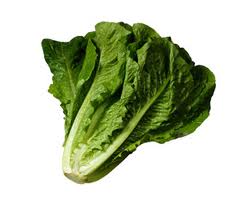 As the name implies, Romaine Lettuce was a product of the Roman Empire. A large bulb with wrinkly leaves, romaine lettuce is known for its crisp taste and texture. When the Pope moved to Avignon in France, this delicious plant was nicknamed Avignon lettuce. Since the Romans were a culture spanning the entire Mediterranean, the use of this lettuce leaf became popular from North Africa to England. Soon, romaine lettuce spread to Asia, where it remains a popular ingredient. The most popular use of Romaine lettuce is by far the Caesar salad. Providing a healthy crunch, it is difficult to replace this leaf when making such a classic dish.
As the name implies, Romaine Lettuce was a product of the Roman Empire. A large bulb with wrinkly leaves, romaine lettuce is known for its crisp taste and texture. When the Pope moved to Avignon in France, this delicious plant was nicknamed Avignon lettuce. Since the Romans were a culture spanning the entire Mediterranean, the use of this lettuce leaf became popular from North Africa to England. Soon, romaine lettuce spread to Asia, where it remains a popular ingredient. The most popular use of Romaine lettuce is by far the Caesar salad. Providing a healthy crunch, it is difficult to replace this leaf when making such a classic dish.
Key Nutrients
All lettuce is a great source of vitamin K and chlorophyll. Romaine lettuce also supplies a high amount of vitamins A, B1, B2, C, folic acid and chromium.
Health Benefits
Vitamin A – Vitamin A, when converted into retinaldehyde, is a vital compound for healthy eyes. Furthermore, vitamin A is believed to fight against cataracts, macular degeneration and glaucoma. Vitamin A strengthens the membranes of the human body such as mucous membranes, respiratory, urinary and intestinal tracts. It is also essential for the lymphocytes, or white blood cells, that fight infection once in the body.
Vitamin C – Regular consumption of foods rich in vitamin C helps the body develop resistance against infections and scavenges harmful, pro-inflammatory free radicals. Vitamin C also helps to prevent respiratory problems such as asthma and lung cancer. Vitamin C has been shown to lower blood pressure, and therefore lessen the probability of hypertension.
Vitamin K – Vitamin-K plays an important role in bone metabolism by promoting osteotrophic activity in bone cells. Vitamin K also acts to clot open wounds and prevent excessive bleeding. Healthy vitamin K levels lower the release of the glycoprotein interleukin-6, a marker of inflammation within the body.
Vitamin B1 – Thiamine is an important vitamin since it breaks down sugars in the body. Thiamine also helps to support nerve and heart health.
Vitamin B6 – Vitamin B6 helps to keep your immune system in good working order. It aids in the breakdown of fats, carbohydrates and amino acids while helping to maintain the health of lymph nodes. Additionally, vitamin B6 helps to regulate blood glucose levels.
Vitamin B9 – Folate is an important vitamin for liver function.
Vitamin B12 – Vitamin B12, or folic acid, helps to preserve neurological function and DNA synthesis. It also plays a key role in the health of red blood cells. The nervous system relies on vitamin B12 for proper function as well.
Season
Romaine lettuce matures in late spring, and continues to grow throughout the summer months. Due to its commercial popularity, you can find this crisp leaf year round in most supermarkets.
Nutrition Information
Per 1 Cup (50 grams):
Calories (cKal): 8
Protein (grams): .58
Total Fat (grams): .14
Carbohydrates (grams): 1.55
Fiber (grams): 1
Buying and Storing
When buying romaine lettuce, make sure to look for crisp leaves with are not brown on the edges and contain no spots. When storing, wrap the base of the head in a damp paper towels then place in a plastic bag. Using this method, you can extend the life of romaine lettuce to up to one week.
Best Way to Add to Diet
Romaine lettuce is best when making a salad. While the Caesar salad is the most popular way to serve this vegetable, it works very well in any salad variety. Additionally, try using romaine lettuce on a sandwich or burger.
Romaine Lettuce Recipe

 Not Sure What Healthy Foods To Eat?
Not Sure What Healthy Foods To Eat? This week we take a look at one of my favorite healthy foods...the mighty Avocado.
This week we take a look at one of my favorite healthy foods...the mighty Avocado.
No comments yet.